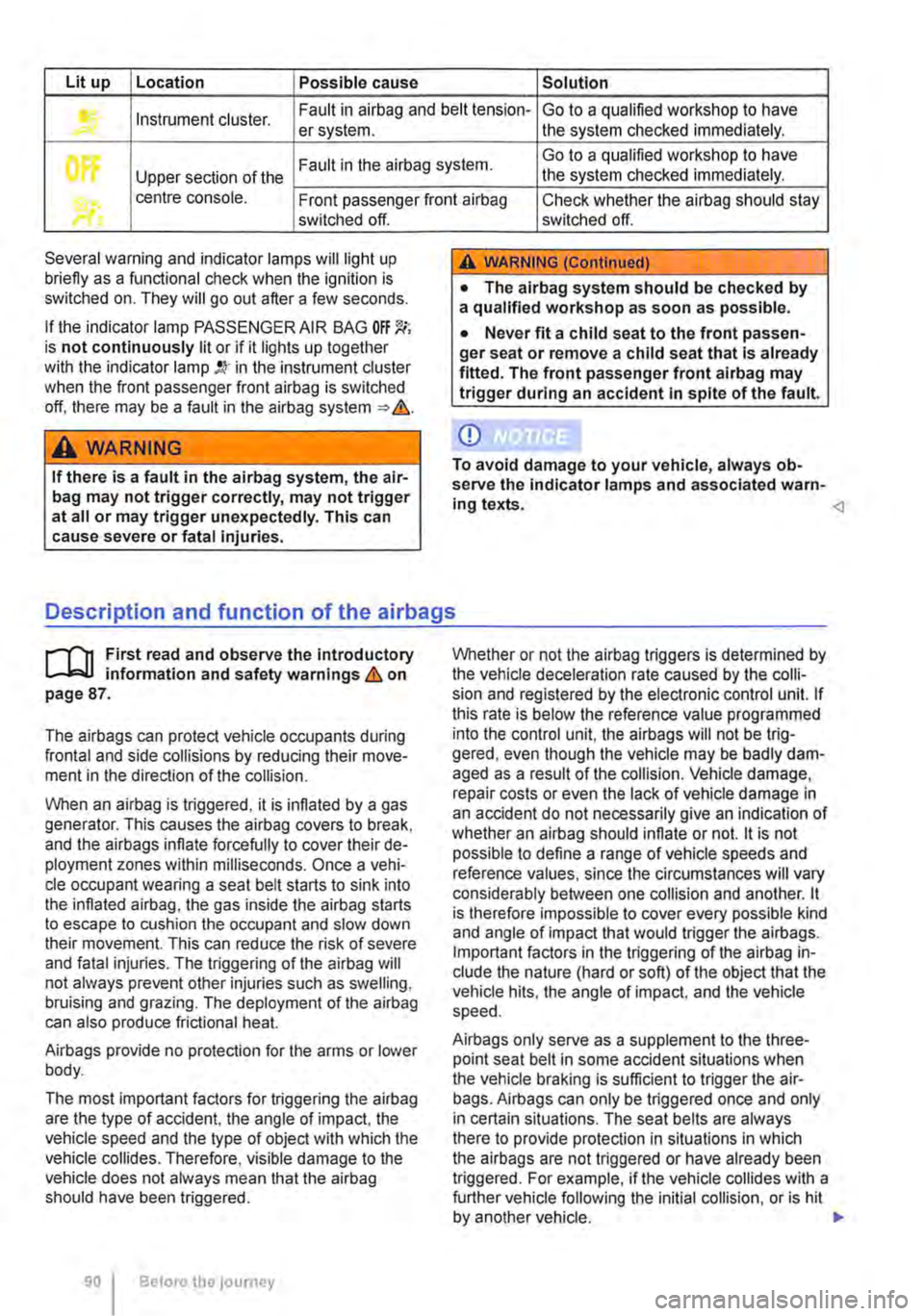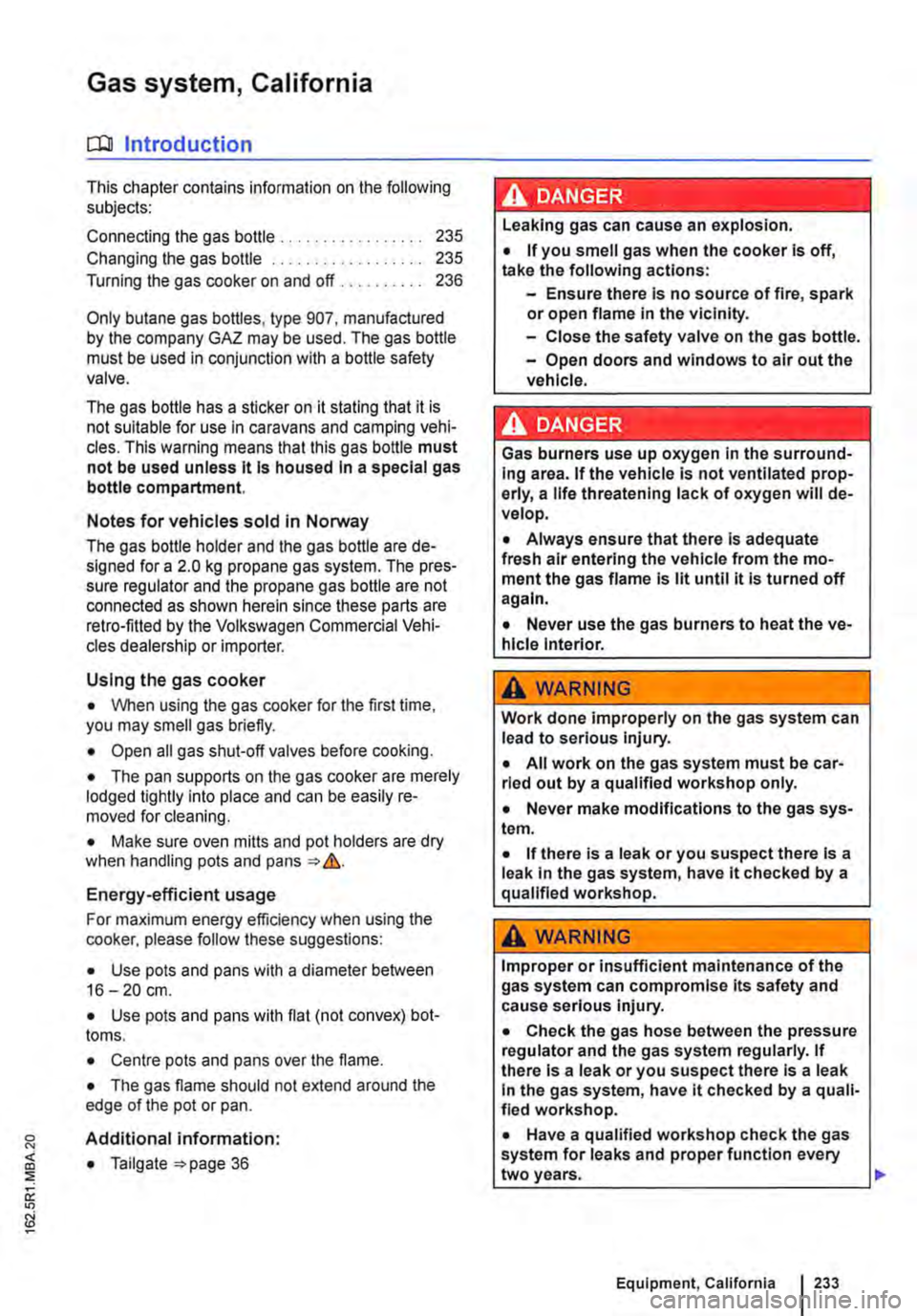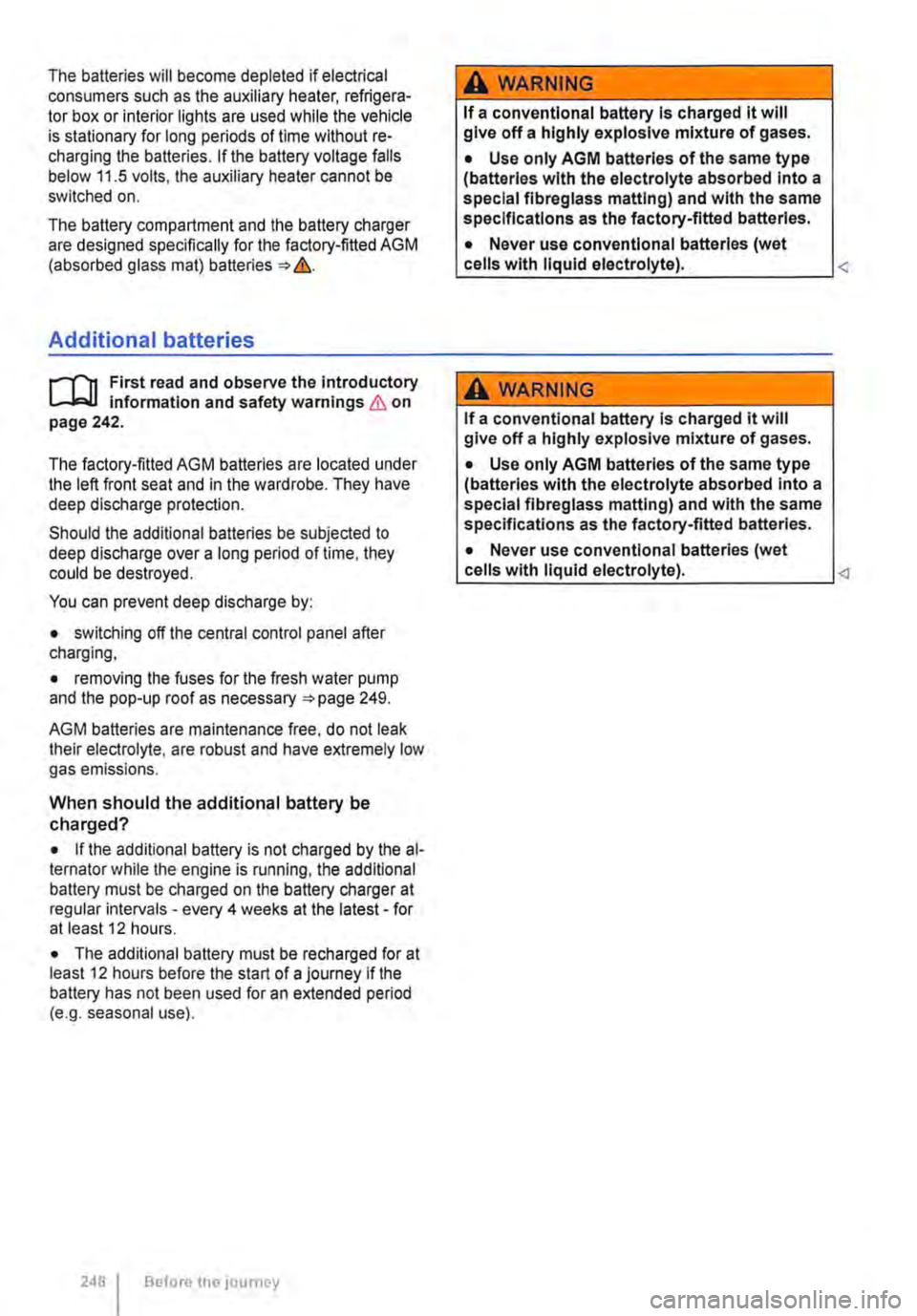2020 VOLKSWAGEN TRANSPORTER gas type
[x] Cancel search: gas typePage 90 of 486

Lit up Location Possible cause Solution
Instrument cluster. Fault in airbag and belt tension-Go to a qualified workshop to have er system. the system checked immediately.
Fault in the airbag system. Go to a qualified workshop to have
Upper section of the the system checked immediately.
• centre console. Front passenger front airbag Check whether the airbag should stay switched off.
Several warning and indicator lamps will light up briefly as a functional check when the ignition is switched on. They will go out after a few seconds.
If the indicator lamp PASSENGER AIR BAG OFF 'J(; is not continuously lit or if it lights up together with the indicator lamp !Q' in the instrument cluster when the front passenger front airbag is switched off. there may be a fault in the airbag system => &.
A WARNING
If there is a fault in the airbag system, the air-bag may not trigger correctly, may not trigger at all or may trigger unexpectedly. This can cause severe or fatal injuries.
switched off.
A WARNING (Continued)
• The alrbag system should be checked by a qualified workshop as soon as possible.
• Never fit a child seat to the front passen-ger seat or remove a child seat that Is already fitted. The front passenger front alrbag may trigger during an accident In spite of the fault.
CD
To avoid damage to your vehicle, always ob-serve the indicator lamps and associated warn-ing texts. <1
Description and function of the airbags
r-('n First read and observe the introductory l..-lc:.l.l information and safety warnings & on page 87.
The airbags can protect vehicle occupants during frontal and side collisions by reducing their move-ment in the direction of the collision.
When an airbag is triggered, it is inflated by a gas generator. This causes the airbag covers to break, and the airbags inflate forcefully to cover their de-ployment zones within milliseconds. Once a vehi-cle occupant wearing a seat belt starts to sink into the inflated airbag, the gas inside the airbag starts to escape to cushion the occupant and slow down their movement. This can reduce the risk of severe and fatal injuries. The triggering of the airbag will not always prevent other injuries such as swelling, bruising and grazing. The deployment of the airbag can also produce frictional heat.
Airbags provide no protection for the arms or lower body.
The most important factors for triggering the airbag are the type of accident, the angle of impact, the vehicle speed and the type of object with which the vehicle collides. Therefore, visible damage to the vehicle does not always mean that the airbag should have been triggered.
90 Before the journey
Whether or not the airbag triggers is determined by the vehicle deceleration rate caused by the colli-sion and registered by the electronic control unit. If this rate is below the reference value programmed into the control unit, the airbags will not be trig-gered, even though the vehicle may be badly dam-aged as a result of the collision. Vehicle damage, repair costs or even the Jack of vehicle damage in an accident do not necessarily give an indication of whether an airbag should inflate or not. it is not possible to define a range of vehicle speeds and reference values, since the circumstances will vary considerably between one collision and another. it is therefore impossible to cover every possible kind and angle of impact that would trigger the airbags. Important factors in the triggering of the airbag in-clude the nature (hard or soft) of the object that the vehicle hits, the angle of impact, and the vehicle speed.
Airbags only serve as a supplement to the three-point seat belt in some accident situations when the vehicle braking is sufficient to trigger the air-bags. Airbags can only be triggered once and only in certain situations. The seat belts are always there to provide protection in situations in which the airbags are not triggered or have already been triggered. For example, if the vehicle collides with a further vehicle following the initial collision, or is hit by another vehicle. .,.
Page 233 of 486

Gas system, California
c:Q Introduction
This chapter contains information on the following subjects:
Connecting the gas bottle . . . . . . . . . . . . . . . . . 235
Changing the gas bottle . . . . . . . . . . . . . . . 235
Turning the gas cooker on and off . . . . . . . . . . 236
Only butane gas bottles, type 907, manufactured by the company GAZ may be used. The gas bottle must be used in conjunction with a bottle safety valve.
The gas bottle has a sticker on it stating that it is not suitable for use in caravans and camping vehi· cles. This warning means that this gas bottle must not be used unless it Is housed In a special gas bottle compartment.
Notes for vehicles sold in Norway
The gas bottle holder and the gas bottle are de-signed for a 2.0 kg propane gas system. The pres-sure regulator and the propane gas bottle are not connected as shown herein since these parts are retro-fitted by the Volkswagen Commercial Vehi-cles dealership or importer.
Using the gas cooker
• When using the gas cooker for the first time, you may smell gas briefly.
• Open all gas shut-off valves before cooking.
• The pan supports on the gas cooker are merely lodged tightly into place and can be easily re-moved for cleaning.
• Make sure oven mitts and pot holders are dry when handling pots and pans => &.
Energy-efficient usage
For maximum energy efficiency when using the cooker, please follow these suggestions:
• Use pots and pans with a diameter between 16-20cm.
• Use pots and pans with flat (not convex) bot-toms.
• Centre pots and pans over the flame.
• The gas flame should not extend around the edge of the pot or pan.
Additional information:
• Tailgate =>page 36
Leaking gas can cause an explosion.
• If you smell gas when the cooker Is off, take the following actions:
-Ensure there Is no source of fire, spark or open flame in the vicinity.
-Close the safety valve on the gas bottle.
-Open doors and windows to air out the vehicle.
Gas burners use up oxygen in the surround-Ing area. If the vehicle is not ventilated prop-erly, a life threatening lack of oxygen will de-velop.
• Always ensure that there is adequate fresh air entering the vehicle from the mo-ment the gas flame Is lit until it Is turned off again.
• Never use the gas burners to heat the ve-hicle Interior.
A WARNING
Work done improperly on the gas system can lead to serious injury.
• All work on the gas system must be car-ried out by a qualified workshop only.
• Never make modifications to the gas sys-tem.
• If there is a leak or you suspect there is a leak In the gas system, have it checked by a qualified workshop.
A WARNING
Improper or insufficient maintenance of the gas system can compromise its safety and cause serious injury.
• Check the gas hose between the pressure regulator and the gas system regularly. If there Is a leak or you suspect there is a leak In the gas system, have it checked by a quali-fied workshop.
• Have a qualified workshop check the gas system for leaks and proper function every two years. .,.
Equipment, California 233
Page 248 of 486

The batteries will become depleted if electrical consumers such as the auxiliary heater, refrigera-tor box or interior lights are used while the vehicle is stationary for long periods of time without re-charging the batteries. If the battery voltage falls below 11.5 volts, the auxiliary heater cannot be switched on.
The battery compartment and the battery charger are designed specifically for the factory-fitted AGM (absorbed glass mat) batteries &.
Additional batteries
r--f'n First read and observe the introductory information and safety warnings & on page 242.
The factory-fitted AGM batteries are located under the left front seat and in the wardrobe. They have deep discharge protection.
Should the additional batteries be subjected to deep discharge over a long period of time, they could be destroyed.
You can prevent deep discharge by:
• switching off the central control panel after charging,
• removing the fuses for the fresh water pump and the pop-up roof as necessary 249.
AGM batteries are maintenance free. do not leak their electrolyte, are robust and have extremely low gas emissions.
When should the additional battery be charged?
• If the additional battery is not charged by the al-ternator while the engine is running, the additional battery must be charged on the battery charger at regular intervals -every 4 weeks at the latest-for at least 12 hours.
• The additional battery must be recharged for at least 12 hours before the start of a journey if the battery has not been used for an extended period (e.g. seasonal use).
248 I Before the JOurney
A WARNING
If a conventional battery Is charged it will give off a highly explosive mixture of gases.
• Use only AGM batteries of the same type (batteries with the electrolyte absorbed Into a special fibreglass matting) and with the same specifications as the factory-fitted batteries.
• Never use conventional batteries (wet cells with liquid electrolyte).
If a conventional battery Is charged it will give off a highly explosive mixture of gases.
• Use only AGM batteries of the same type (batteries with the electrolyte absorbed into a special fibreglass matting) and with the same specifications as the factory-fitted batteries.
• Never use conventional batteries (wet cells with liquid electrolyte).
Page 256 of 486

Refrigerator box
Gas system
Water supply
Water disposal
256 I Before the journey
Connected load: 22 watts
Voltage: 12 volt
Connected load: max. 54 watts
Temperature: adjustable
Refrigerator box capacity: 42 litres
Gas bottle GAZ, type 907, with pressure regulator (30 mbar) and bottle safety valve
Bottle capacity: 2.8 kg
Operating pressure: 30 mbar
Gas consumption per flame: max. 140 glh
Fresh water tank with immersed electric pump, wa-ter level sensor and drain valve under the vehicle.
Fresh water tank capacity: approx. 30 litres
Connected load: 15 watts
waste water tank with water level sensor and a drain valve under the vehicle.
waste water tank capacity: approx. 30 litres
Page 355 of 486

The correct engine oil is important for the function and service life of the engine. A special high quali-ty multigrade oil has been filled at the factory and this can normally be used as an all-season oil.
If possible, only use Volkswagen-approved engine oil =>CD. To comply with the requirements of the flexible service, only use approved flexible service engine oil that complies with the corresponding VW standard =>table on page 355. The engine oils listed are multigrade high-lubricity oils.
Engine oils are constantly being developed and im-proved. Volkswagen Commercial Vehicles dealers are kept up to date with regard to any changes. Volkswagen Commercial Vehicles therefore recom-mends having engine oil changes done by a Volks-wagen Commercial Vehicles dealer.
The quality of the engine oil is not only tailored to the requirements of engines and exhaust gas treat-ment systems, but also to fuel quality. Due to the
way in which a combustion engine works, engine oil always comes into contact with combustion resi-dues and fuel, which has a knock-on effect on the ageing process of the oil.
The quality of fuels can vary greatly between indi-vidual markets and this must be taken into account when selecting the correct engine oil.
The use of engine oils compliant with the VW 504 00 und VW 507 00 specifications requires a fuel quality compliant with EN 228 (petrol) and EN 590 (diesel), or fuel of an equivalent quality. Engine oils compliant with VW 504 00 und VW 507 00 are therefore unsuitable for use in a large number of markets.
Permitted engine oil specifications =>CD
Engine type Flexible service QIS, QIS Fixed service Ql1, Ql2, Q13, Ql4, Ql5
110 kW petrol engine VW504 00
150 kW petrol engine -
All diesel engines with DPF VW507 00
All diesel engines without DPF VW507 00
CD
• Do not add any additional lubricants to the engine oil. Any damage caused by the use of such additives is not covered by the warranty.
• Only engine oil specifications that have been approved for use with the engine should be used. Using other engine oils can cause en-gine damage.
• Another engine oil can be used in the event of an emergency if the listed engine oils (=>table on page 355) are not available. To
vw 502 00
VW502 00
VW507 00
VW505 01
CD
avoid damaging the engine, a maximum quanti-ty of 0.5 litres of the following engine oil may be used only once until the next oil change:
-Petrol engines: standards ACEAA3/B4 or API SN (API SM).
-Diesel engines: standards ACEA C3 or APICJ4.
In the engine compartment 1355